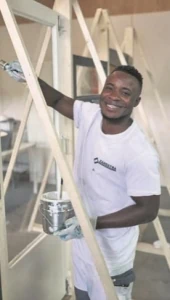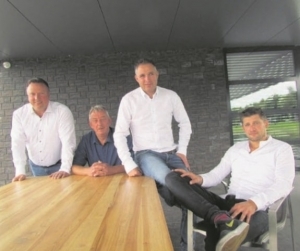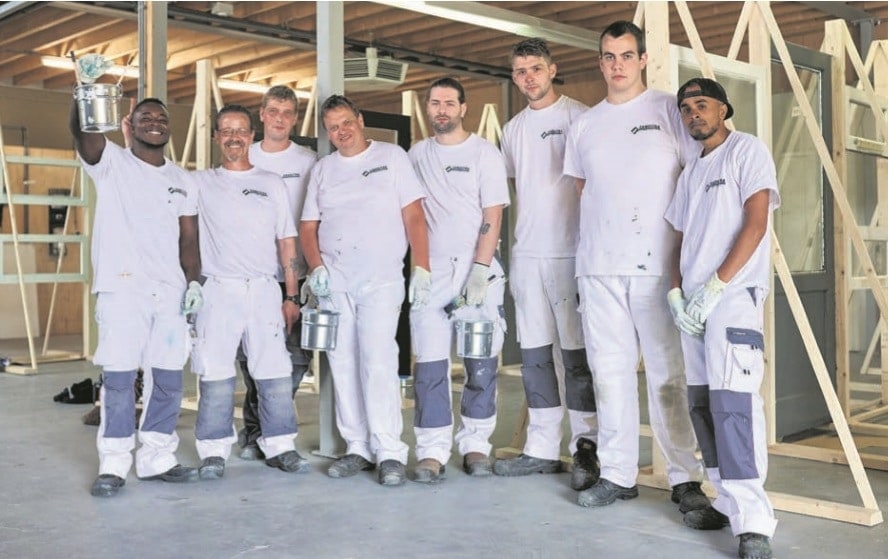Painting employment project in Stadskanaal municipality successful for second year
‘Not far- but béjudice’
STADSKANAAL – The Stadskanaal municipality is eager to help a number of hard-to-employ unemployed people. And painting companies don’t know where to get new employees. One and one is two, you might say. A win-win situation. It’s a bit more complicated. And yet in Stadskanaal they manage to achieve this double goal. Year after year.
To get these unemployed people to work, a lot of resistance had to be overcome: prejudice, unwillingness, investment in time and money, ignorance, resignation. “I admit it honestly,” says Bert Eling, director-owner of Zandstra Schilderwerken in Stadskanaal, “It took a while before I too could get over my prejudice. About the fact that I couldn’t imagine that “guys like that”, who had been sitting at home for I don’t know how long, could mean anything to us. Fortunately, I now know better. For various reasons, such as insecurity, social problems and illness, there are a lot of people on welfare who would love to work, but without this push, they cannot get out of isolation. And there are very good people among them. By the way, also vice versa: people of whom I still think: that will never amount to anything. Back in 2015, the first and successful project started.
‘A chance to get out of isolation’
Erik Lassche, director of employment agency M-Ployee in Stadskanaal, had been in contact with the Stadskanaal municipality since 2014 about how companies could achieve corporate social responsibility goals and how hard-to-employ people would be moved to take an interest in different sectors. This included the painting sector. You need partners for that. It is no coincidence that M-Ployee’s opposite neighbor, Zandstra Schilderwerken and also its neighbor, SealteQ, preserver of steel and concrete works, soon stepped in to explore the possibilities.

Eling: “We saw the problem of a labor shortage coming our way a long time ago, of course. Now, with an improving market and an accelerating aging population, the shortage of people is increasing by the day. Back then, we were already thinking about where the “hands would soon have to come from.” Training could theoretically offer a solution, but things are stagnating there for various reasons. Lassche: ‘Parents often prefer general education, such as vmbo-t or havo, rather than vocational education. Ict and administrative is preferred. Familiarity with the diversity of the craft of painting is also lacking.’ Lassche: ‘Again, education is the core of this project. Very practical in approach. Six weeks of learning basic skills and safety instructions. But not before we first held discussions, so-called speed dates, with the potential participants. Also the project that is now running, already for the second consecutive year.
After 15 interviews, 10 started the training, the maximum number to be placed.’ Albert-Jan Kamping, project manager at SealteQ: ‘We also present ourselves, because after that basic training and an internship period they can choose. Either for us, then they go to work as construction painters of steel and concrete in infrastructure works such as bridges and viaducts, or for Zandstra as painters in construction.’ Marcel Nijmanting, project manager and supervisor of the boys at Zandstra Schilderwerken, adds: ‘Just because someone can’t hold a smooth job interview doesn’t mean they can’t understand their trade. Give them the benefit of the doubt and allow them to build confidence. That is often what is lacking. We show them what the profession is all about. Plus we show them that we are investing in them, that we want to offer them a professional perspective. Eling: ‘So don’t judge, but judge.’ Kamping: ‘Fortunately, some of the participants see it as an opportunity to get out of isolation. Indeed, a win-win situation.’ Without having formulated an explicit corporate goal of corporate social responsibility (CSR), the partners realize that the project, especially initially, costs money. Also, setting up a painting training course in the premises of TSH (Technical Support Holland) in Emmen requires the necessary investments.
Kamping: “No, this is not a grant program, but an investment. Time, company clothing, toolbox, materials and transportation, things like that. For all, including those who can’t make it.’ During the period of the project, six months, participants work on benefits, with no additional earnings. Kamping: “But if someone does well, you can already outline a possible future path and hold out the prospect of something. For example, someone from the previous program indicated that he would like to get his driver’s license. That has since happened. He now also has a permanent contract. Eling: ‘The previous project also left us with a great employee. Of course we hired him. A great person. You can enjoy the fact that something like that works.
‘If it works out, you can enjoy that’
Of course, no unlimited stream of employees can flow out through this project to the two participating companies. Nijmanting: “Given the number of apprenticeships, we can supervise four guys within our company. They deserve that. You can’t leave them to their own devices. They must be allowed and able to make mistakes during the training and there must be sufficient capacity to explain and guide them. The boys all have their own pasts and bring diverse characters with them. They also come into an existing work culture. It is up to us to deal with that properly.
go. Eling: ‘We have our own rules of conduct within the companies. Treating each other with respect is very important. That doesn’t always work immediately, but then they are given the opportunity to adjust and learn that. And if not, it stops. One point of attention is the timing of the project. Kamping: “If you organize it during the high season, as is the case now, you put a lot of pressure on yourself. After all, you take your own people out of the company in order to be able to supervise the boys intensively, both technically and socially. As far as we are concerned, this can also be done in a better period.’ Lassche: “That mainly has to do with the differences in business and organizational culture between the municipality, us as an employment intermediary and Zandstra and SealteQ. Kamping: “It would also be good for the boys not to fall back into old habits, especially in the winter. Lassche: ‘In an own training center, if possible for several professions. We are thinking about that too.’ None of which takes away from the fact that the project will continue next year.
Then all participating parties will again make money,time, people and resources available to once again talk to 15 candidates about whether they are suitable for the painting trade. And just like last year, the municipality will make some maintenance projects available for that purpose this year as well, where the participants can master the trade. These include schools, a sports hall and a gymnasium, as well as the maintenance of bridges and overpasses. And given the economic outlook, the Zandstra Schilderwerken and SealteQ can use some extra labor in the near future.



